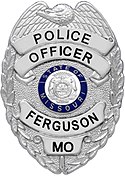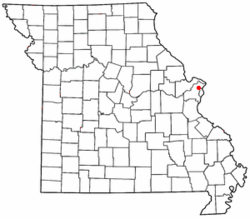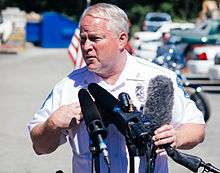Ferguson Police Department (Missouri)
The Ferguson Missouri Police Department (FPD) is a law enforcement agency serving Ferguson, Missouri. Since June 25, 2019, the Current Chief of Police has been Jason Armstrong Since Former Chief Delrish Moss resigned.[3]
| Ferguson Police Department | |
|---|---|
 | |
 | |
 Flag of the City of Ferguson | |
| Abbreviation | FPD |
| Agency overview | |
| Formed | 1894 |
| Employees | 72[1] |
| Annual budget | $9,573,300 USD (2020) |
| Jurisdictional structure | |
| Operations jurisdiction | Ferguson, Missouri, United States |
 | |
| Map of Ferguson Police Department's jurisdiction. | |
| Population | 20,730 (2018) |
| Legal jurisdiction | Ferguson, Missouri |
| Governing body | City council |
| General nature | |
| Operational structure | |
| Headquarters | 222 S. Florissant Road |
| Sworn members | 48[1] |
| Unsworn members | 24[1] |
| Mayor of Ferguson responsible | |
| Agency executives |
|
| Parent agency | Ferguson, Missouri |
| Facilities | |
| Detention centers | Ferguson Detention Center 222 S. Florissant Road |
| Marked and Unmarkeds | Chevrolet Tahoes, Ford Crown Victorias and Harley-Davidson Police Motorcycles |
| K-9s | 3 |
| Website | |
| Ferguson Police Department official website | |
Col . Jason Armstrong was appointed as the Chief of Police of Ferguson Police on July 25, 2019 by then Mayor James Knowles III, and is Ferguson's third African-American Chief of Police .[3]
A federal investigation by the United States Department of Justice initiated in the aftermath of the 2014 Ferguson unrest, found that the Ferguson police department routinely stereotyped and discriminated against African American residents in violation of the Constitution.[4]
Organization
The Ferguson Police Department includes sixty-two including forty-five officers and seventeen civilian support staff.[1] The officers are all police academy graduates and certified peace officers by the Missouri Department of Public Safety.[1]
Three supervisors as well as the chief are graduates of the FBI National Academy.[1] Many officers have bachelors or advanced degrees.[1] All officers participate in advanced continuous training in numerous areas of law enforcement.[1]
In addition to uniformed patrols of policemen and criminal investigation detectives, the department is supplemented with four K-9 officers, a bicycle patrol, and a traffic unit.[1] The department has its own correctional facility, maintains evidence and property, and on-site indoor firearms range.[1]
The department's relationship with the community is enhanced by commitment of personnel to the positions of community relations, business liaison, Drug Abuse Resistance Education ("DARE"), and school resource officers.[1]
Rank structure
| Title | Insignia |
|---|---|
| Chief of Police | |
| Assistant Chief | |
| Captain | |
| Lieutenant | |
| Sergeant | |
| Officer |
Equipment
Weapons
- SIG Sauer P229 .40-caliber semiautomatic handgun[6][7]
- AR-15 rifle[8]
- Taser conducted electrical weapon[9]
Body cameras
In late August 2014, Ferguson police officers began wearing body-mounted video cameras donated by Safety Visions and Digital Ally. Fifty cameras were donated.[10]
On December 1, 2014 President Barack Obama announced that the federal government will spend US$75 million on body cameras for law enforcement officers, as one of the measures taken in response to the shooting in Ferguson.[11]
Incidents
2009 Henry Davis incident
In September 2009, officers mistakenly arrested Henry Davis based on an outstanding warrant for another man with the same name. While in custody, Davis was allegedly beaten by four officers. Davis was charged with "property damage" supposedly for bleeding on the officers' uniforms.[12] Davis had been arrested on suspicion of driving under the influence. Davis later pleaded guilty to two reduced charges and filed a lawsuit against the officers and the department. On July 28, 2015, an appeals court ruled that Davis could continue his excessive-force suit against the Ferguson Police Department.[13]
Hiring issue
Between July 2009 and December 2010, the department hired a police officer who had previously been fired from the St. Louis County Police Department after being accused of assaulting two minors, one a 12-year-old girl, with his service weapon. The officer was acquitted of the charges in 2010.[14] A state commission found the man had committed "a criminal act".[15][16]
2011 death of Jason Moore
In September 2011, a Ferguson police officer used a TASER device on Jason Moore. After Moore ran down the street yelling and pounding on cars, the officer used the TASER device on him. When Moore tried to get up from the ground, the officer used the TASER twice more and Moore then stopped breathing. He died of a heart attack.[17] His family filed a wrongful death lawsuit against the Ferguson Police Department for the death.[9][17] On November 4, 2016, a federal jury awarded $3 million to the family.[18] Although the city initially appealed the jury verdict, it later agreed on February 1, 2017 to pay the full amount to settle the lawsuit and end the case.[19]
2014 shooting of Michael Brown and unrest
On August 9, 2014, Michael Brown, an unarmed teenager, was fatally shot by Ferguson police officer Darren Wilson whilehe was sitting in his patrol car on duty.[20] Brown attacked the officer, fracturing the officer's skull and struggle for control of the officer's service weapon. Brown was shot while facing the officer according to FBI reports. Chief of Police Tom Jackson claimed in a news conference[21] that Brown had been a suspect in a "strong-arm" robbery, but later stated that the robbery was not connected to Officer Wilson's interaction with Brown.[22] The later Department of Justice investigation later described Officer Wilson as having heard the description of the robbery and suspect before he encountered Brown, although Officer Wilson could not recount the specifics of what he heard.[23]
Both peaceful protests and civil disorder began following Brown's shooting and lasted for several days. Police grappled with establishing curfews and maintaining order, inciting further unrest. On August 10, a day of memorials began peacefully, but some crowd members became unruly after an evening candlelight vigil.[24] Local police stations assembled approximately 150 officers in riot gear.[24]

Chief of Police Tom Jackson drew criticism for his department's release of information about Brown's death, which was described by the Associated Press as "infrequent" and "erratic", as well as for the aggressive response to the unrest.[25]
Jackson said that his top priority in Ferguson was race relations and committed to reach across the racial, economic, and generational divides in the community to find solutions, and said he welcomed the Justice Department training on racial relations between police and the residents, in which two-thirds of the residents are black and all but three of the police force's fifty-three officers are white.[26]
Six weeks after the incident, a press relations firm released a video in which Jackson apologized to Brown's family for taking too long to remove Brown's body from the street, and to the peaceful protesters who felt they couldn't exercise their Constitutional rights, saying that "For any mistakes I've made, I take full responsibility". He also said that he was truly sorry for the loss of their son. An attorney for Brown's family responded that the apology came at a time in which trust in Jackson "has reached an irreversible low".[27]
On October 24, Amnesty International published a report detailing human rights abuses by Ferguson police. The report cited the use of lethal force in Brown's death, racial discrimination and excessive use of police force, imposition of restrictions on the rights to protest, intimidation of protesters, the use of tear gas, rubber bullets, and long range acoustic devices, restrictions imposed on the media covering the protests, and lack of accountability for law enforcement policing protests.[28][29]
A grand jury declined to indict Wilson which led to further protests, some of which were violent.[30][31] This incident and the aftermath resulted in world-wide criticism of police tactics and highlighted racism in the United States.[31] The U.S. Department of Justice concluded Wilson shot Brown in self-defense.[32]
Justice Department investigation and report
In September 2014, the United States Justice Department initiated a civil rights investigation to examine concerns about the Ferguson Police Department's practices, as well as reviewing its internal investigations of use of force during the preceding four years.[33][34] Jackson said he welcomed the investigation.[34] The DOJ investigation concluded that police officers in Ferguson routinely violated the constitutional rights of the city's residents by applying racial stereotypes and discriminating against African-Americans.[35] Internal City of Ferguson e-mails indicated that town officials have been viewing the department as a revenue source.
An article in The Washington Post[36] highlighted key insights gleaned from the report, which they describe as "scathing", including:
- The city's practices were shaped by revenue rather than by public safety needs.
- A single missed, late or partial payment of a fine could mean jail time.
- Arrest warrants were "almost exclusively" used as threats to push for payments.
- The 67% of African Americans in Ferguson account for 93% of arrests made from 2012–2014.
- The disproportionate number of arrests, tickets and use of force stemmed from "at least in part, because of unlawful bias," rather than black people committing more crime.
- Officers used canines in law enforcement, but in every dog bite incident reported, the person bitten was Black.
- From October 2012 to October 2014, every time a person was arrested because he or she was "resisting arrest," that person was Black.
The Los Angeles Times published a piece addressing a municipal code called "manner of walking along roadway" described in the report. This code is designed to require pedestrians to walk on the sidewalks or on the side of the road, but according to the report, Ferguson police used the code to harass Blacks, with African Americans accounting for 95% of "manner of walking along roadway" charges from 2011 to 2013.[37] The town imposes the highest fines in the region for violations of "manner of walking."[38]
VOX summarized key findings in the report, including police and municipal officials sending racist emails, police arresting Black residents when they were trying to care for loved ones who were hurt, officers abusing their power and disregarding the law as part of the department's culture while supervisors supported them, and the police department's using race to dictate who would be stopped and the level of force used against them.[39]
Chief Jackson resigned on March 11, 2015, following the release of the Justice Department report and the firing of five Ferguson city officials and police officers. His resignation became effective March 19, when Lieutenant Colonel Al Eickhoff taking over as acting chief.[40] The decision to let Jackson resign rather than be fired is controversial, particularly since his contract was to expire in March anyway and his resignation guaranteed him one year of pay and one year's continuation of his paid health insurance.[40]
References
- "Administration - Ferguson, MO - Official Website". City of Ferguson Police Department. City of Ferguson. Retrieved 4 December 2014.
- "New police chief says he's 'honored' to take over in Ferguson". stltoday.com. 2019-06-24. Retrieved 2019-09-11.
- Viviano, Katy (2019-06-25). "Ferguson hires new full-time police chief". fox2now.com. Retrieved 2019-09-11.
- United States Department of Justice – Civil Rights Division (2015-03-04). Investigation of the Ferguson Police Department (PDF) (Report). pp. 15–89. Retrieved 2019-09-23.
IV. FERGUSON LAW ENFORCEMENT PRACTICES VIOLATE THE LAW AND UNDERMINE COMMUNITY TRUST, ESPECIALLY AMONG AFRICAN AMERICANS
- Lamothe, Dan (19 August 2014). "Pentagon defends program supplying military gear to Ferguson police". Washington Post. Retrieved 4 December 2014.
- Sanchez, Ray (November 26, 2014). "Darren Wilson says he's sorry but his conscience is clear". CNN. Retrieved 4 December 2014.
- Calamur, Krishnadev (November 25, 2014). "Ferguson Documents: The Physical Evidence". NPR. Retrieved 4 December 2014.
- Currier, Joel (November 26, 2014). "AR-15 rifle stolen from St. Louis County police car torched by rioters in Ferguson". St. Louis Post-Dispatch. Retrieved 4 December 2014.
- John Eligon and Michael S. Schmidt, "In Ferguson, Scrutiny on Police Is Growing", New York Times, August 20, 2014.
- Hollinshed, Denise (September 1, 2014). "Ferguson police are using body cameras". St. Louis Post-Dispatch. Retrieved September 1, 2014.
- "Obama to announce $75 million for body cameras".
- "The Day Ferguson Cops Were Caught in a Bloody Lie". The Daily Beast. Retrieved 1 December 2014.
- Daly, Michael (29 July 2015). "Ferguson Prisoner Beaten by Cops Has Won His Appeal". Daily Beast. Retrieved 10 February 2016.
- Matt Sledge, "Ferguson Hired Officer With History Of Allegedly Hitting Children", Huffington Post, August 19, 2014.
- "From Ferguson Cop Embroiled in a Brutality Suit to City Councilwoman". The Daily Beast. Retrieved 1 December 2014.
- "Before Mike Brown Shooting, Ferguson Police Department Had History Of Misconduct Allegations". International Business Times. 18 August 2014. Retrieved 1 December 2014.
- Thorsen, Leah (20 August 2014). "New lawsuit alleges Ferguson officers used Taser on mentally ill man in 2011, killing him". St. Louis Post Dispatch. Retrieved 5 December 2014.
- Patrick, Robert. "Jury awards $3 million to relatives of man who died after Tasing by Ferguson police". stltoday.com. Retrieved 2016-11-06.
- Patrick, Robert. "Settled: Ferguson pays $3 million to family of naked, unarmed man who died after police encounter". stltoday.com. Retrieved 2017-02-04.
- Schmidt, Michael S.; Apuzzo, Matt; Bosman, Julie (October 17, 2014). "Police Officer in Ferguson Is Said to Recount a Struggle". The New York Times. Archived from the original on 2014-10-18. Retrieved October 18, 2014.
- Berman, Mark (15 August 2014). "Ferguson police say Michael Brown was a robbery suspect, identify Darren Wilson as officer who shot him". The Washington Post. Retrieved 14 March 2015.
- Larimer, Sarah (11 March 2015). "'I understand the frustration': Ferguson Police Chief Tom Jackson, in his own words". The Washington Post. Retrieved 14 March 2015.
- https://www.justice.gov/sites/default/files/opa/press-releases/attachments/2015/03/04/doj_report_on_shooting_of_michael_brown_1.pdf
- "Looting Erupts After Vigil for Slain Missouri Teen Michael Brown". NBC News. Associated Press. August 10, 2014. Archived from the original on 2014-08-13. Retrieved August 20, 2014.
- "Ferguson Police Chief Thomas Jackson cedes much of his authority". Fox News. Archived from the original on 2014-08-19. Retrieved 15 September 2014.
- Alan Scher Zagier, Jeff Roberson. "Amid criticism, police defend use of tear gas at Ferguson protests". Kansas City Star. Archived from the original on 2014-08-17. Retrieved 15 September 2014.
- "Ferguson police chief apologizes to Michael Brown's family in video". St. Louis Dispatch. Retrieved 29 September 2014.
- "On the Streets of America: Human Rights Abuses in Ferguson". Amnesty International. October 24, 2014. Archived from the original on October 24, 2014. Retrieved October 25, 2014.
- Alter, Charlotte (October 24, 2014). "3 Key Takeaways From Amnesty International's Ferguson Report". Time. Archived from the original on October 24, 2014. Retrieved October 25, 2014.
- Basu, Moni; Ellis, Ralph; Ford, Dana (November 24, 2014). "No indictment in Michael Brown shooting". CNN. Retrieved November 24, 2014.
- "Ferguson shooting: Protests spread across US". BBC. Retrieved November 26, 2014.
- Phelps, Timothy M.; Muskal, Michael (March 4, 2015). "Federal report largely backs Darren Wilson in Ferguson police shooting case". Los Angeles Times. Archived from the original on March 18, 2015. Retrieved March 25, 2015.
- Bill Chappell. "One Month Later: Michael Brown's Family Calls For Arrest". NPR. Archived from the original on 2014-09-14. Retrieved 10 September 2014.
- "Justice Dept. Inquiry to Focus on Practices of Police in Ferguson". The New York Times. Archived from the original on 2014-09-15. Retrieved 14 September 2014.
- "Justice Department Finds Pattern of Police Bias and Excessive Force in Ferguson". The New York Times. Retrieved 3 March 2015.
- "The 12 key highlights from the DOJ's scathing Ferguson report". The washington Post. Retrieved 7 March 2015.
- "Walking in Ferguson: If you're black, it's often against the law". Los Angeles Times. Retrieved 7 March 2015.
- Robertson, Campbell (4 March 2015). "A City Where Policing, Discrimination and Raising Revenue Went Hand in Hand". New York TImes. Retrieved 5 March 2015.
- "The 6 most damning findings from the DOJ's report on racism in the city of Ferguson". Vox. Retrieved 7 March 2015.
- Sidner, Sara; Shoichet, Catherine E.; Cummings, Julian. "Ferguson police chief resigns, says it's 'hard pill to swallow'". www.cnn.com. CNN. Retrieved March 11, 2015.
External links
| Wikisource has original text related to this article: |
- Official website

- Ferguson Police on LocalWiki
- Investigation of the Ferguson Police Department (Archive) - U.S. Department of Justice Civil Rights Division - March 4, 2015